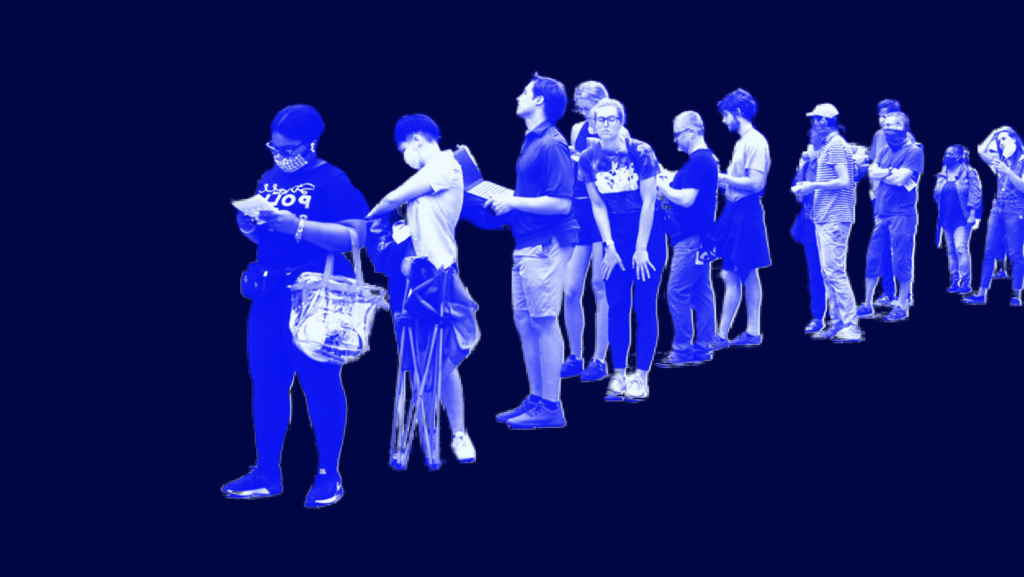How Long Would You Wait To Vote?

How long would you be willing to stand in line to vote? This is the question I find myself asking people these days.
Every election, millions of Americans must weigh standing in line for an hour or two — or five or six — against childcare obligations, time off from work or school and inclement weather. They need to calculate whether all this time standing and waiting in line is worth casting a single vote.
Every election, the excuses for long lines from election administrators remain the same: not enough poll workers, not enough polling locations, not enough ballots and outdated or broken voting equipment.
And, every election, the faces of the voters standing in these lines remain the same: overwhelmingly, they are Black voters, Latino voters and young voters.
In 2004, college students in Knox County, Ohio waited in line for 10 hours to vote. Students at Ohio State University faced only slightly shorter lines. That year, Ohio was the deciding state in the presidential election.
After the 2004 election, the Washington Post found that places in the state with the fewest voting machines per registered voter supported John Kerry, whereas those places with the highest number of machines per voter supported George Bush.
In 2008 and 2012, we again witnessed unconscionably long lines that were disproportionately comprised of Black, brown and young voters. The excuse: don’t worry, this is just a sign of enthusiasm for President Obama!
Nonsense.
After the 2012 elections, President Obama declared “When any American, no matter where they live or what their party, are denied that right because they can’t afford to wait for five or six or seven hours just to cast their ballot, we are betraying our ideals.” He vowed: “We can fix this and we will. The American people demand it. And so does our Democracy.”
Yet, four years later in 2016, long lines remained a feature of our presidential elections — and they continued to disproportionately impact non-white and younger voters.
In the 2016 Democratic primary election, voters in the largest county in Arizona faced three-hour lines. The reason: the county decided to reduce the number of its polling locations from 200 to 60. “It saves a lot of money,” the spokesperson for the Republican county election officials told the media. Unsurprisingly, the county was 43% non-white and, in the Democratic primary, non-white voters outnumbered white voters.
In the 2016 general election, we once again saw debilitatingly long lines. One national election expert called it “pretty much what we expected to see.” The Associated Press cheerfully put it this way: “few voters who went to the polls Tuesday encountered problems—and even then, most of the trouble involved the usual machine breakdowns and long lines.”
Unsurprisingly, the 2020 primaries have been marred with the same long lines. But this time, voters are forced to expose themselves to a potentially deadly virus — just to exercise their fundamental right to vote.
In the April primary, Wisconsin voters saw outrageously long lines due to mass poll closures and an unwillingness by Republicans to take the steps necessary to ensure voter safety.
Nevada had long lines in its primary after the Republican secretary of state took steps to close all but one polling location per county. A lawsuit led to the opening of three additional polling locations in the heavily Democratic Clark County, where nearly 80% of Nevada’s population lives.
And of course, we all saw the lines in Georgia last week, where equipment and staffing problems drove up wait times in heavily African American areas of the metro-Atlanta counties.
It is no wonder that a recent study showed that in 2016, residents of entirely Black neighborhoods waited 29% longer to vote than their counterparts in entirely white neighborhoods. This disparity held up even within the same counties.
Far too many election officials accept long lines, election after election, as the “usual.” Others accept long lines in minority communities as a cynical trade-off to ensure that members of their white communities don’t complain. Finally, others seek a partisan advantage.
Undoubtedly, some election officials will react by claiming that this time, at least, the excuses that they give for the long lines are real — we have a pandemic, new equipment and a lack of resources.
As George Washington Carver said: “Ninety-nine percent of the failures come from people who have the habit of making excuses.”
With only five months before the election, we must urgently act on President Obama’s words.
We must demand election officials offer concrete plans — not platitudes — for how they will avoid long lines this November.
We must demand election officials detail how they are going to ensure that wealthier communities and white voters equally share the burden of equipment and poll worker shortages, so that wait times are equally distributed across all racial and socioeconomic groups.
We must demand the media cover this as a violation of democracy, not an established norm.
And, if the politicians fail to act, we must demand the courts step in to solve this problem and protect voters.
If we don’t do everything within our power to solve this failure of democracy, and we wake up after the election with headlines again describing long lines in minority communities, please don’t say we didn’t know. Just admit that we didn’t care.